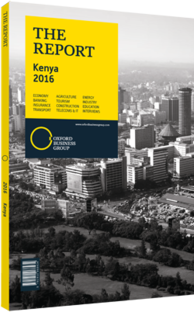Kenyan banks competing for mobile banking customers
Nowhere is the ability of Kenyans to turn technology to commercial use better illustrated than in mobile banking. They use their phones to pay for goods and bills, make deposits and withdraw cash from agents, buy insurance, for public transport and to transfer to relatives. According to the Central Bank of Kenya (CBK), the value of transactions carried out through mobile phones rose 24.7% to KSh2.4trn ($26.4bn) in 2014, compared to KSh1.9trn ($20.9bn) in 2013. Growth drivers include rising use by merchants and individuals due to convenience, cost-effectiveness and security. As public transport starts to enforce cashless payments, usage is likely to rise.
Competition between mobile money offerings has meant aggressive marketing by Safaricom, Orange, Airtel, MobiKash, Tangaza Pesa and Equity Bank, as well as by many other banks and service providers that use mobile money to serve their clients. In August 2015 Kenya Commercial Bank (KCB) and mobile operator Airtel announced a partnership for Airtel Money customers to deposit or withdraw cash in the bank’s outlets. Airtel Money also issues a visa card.
Origins
Telecoms firm Safaricom, which held 67% of the mobile market in the second quarter of 2015, launched its M-Pesa service in 2007. M-Pesa has achieved tremendous growth in Kenya since its launch, and in March 2015 recorded a 14% y-o-y rise in its “30-day active” users to 13.9mm, with total transactional value through M-Pesa up 26% to KSh4.18trn ($46bn). It now plays a major role as a revenue stream for the operator. Mobile money contributed 33% of Safaricom’s total revenue for the year to March 2015, up from 27% the year before.
As with other mobile money services in the country, such as Airtel Money, Mobikash, Orange, Tangaza Pesa and Equitel, the offerings are diverse, ranging from loan products that allow users to save and borrow small amounts using their mobile phones to emergency payment instruments for electricity.
One- Off Success
The mobile money success story was a combination of happenstance, smart regulation and market dominance. The programme’s dramatic take-off benefitted from a number of factors, including high demand as a result of limited financial access among the broader population, a light-touch regulatory approach by the Central Bank and Safaricom’s majority market share. The latest FinAccess National Survey 2013 showed that the number of adults who use mobile phone financial services was 11.5m, more than double the 5.4m who use bank accounts.
While mobile money products have spread across Africa, few countries have seen the same impressive results as Kenya. Even in neighbouring Tanzania, where the population is roughly the same size, initial results for the launch of M-Pesa were much more modest. Further afield, in countries like Nigeria, Senegal, South Africa and Ghana, mobile money programmes have had only a limited impact.
Broader Trend
Banks will continue to favour technology-fuelled growth, as the lowest cost mechanism for service delivery. By and large, banks favour mobile and agency growth, rather than rolling out automatic teller machines and branches.
The EAC aims for low cross-border money transfer rates from the end of 2015, as Kenya, Rwanda, Uganda and South Sudan are now formulating harmonised money-transfer guidelines. It would enable international remittances between M-Pesa, Airtel and Telekom Kenya to MTN mobile-money customers in Uganda, Rwanda and South Sudan.
Equity Bank, Kenya’s biggest bank, is taking on the mobile money operators. It launched its telecoms unit, Equitel, after getting a licence in April 2014 from the Communications Authority to launch a mobile virtual network operator using Airtel’s network. At the July 2015 launch James Mwangi, group managing director and CEO, said, “We will be leveraging on the bank’s presence across the region to roll out Equitel.”
You have reached the limit of premium articles you can view for free.
Choose from the options below to purchase print or digital editions of our Reports. You can also purchase a website subscription giving you unlimited access to all of our Reports online for 12 months.
If you have already purchased this Report or have a website subscription, please login to continue.

